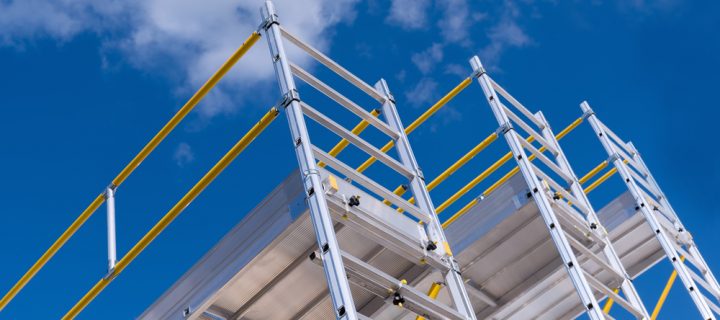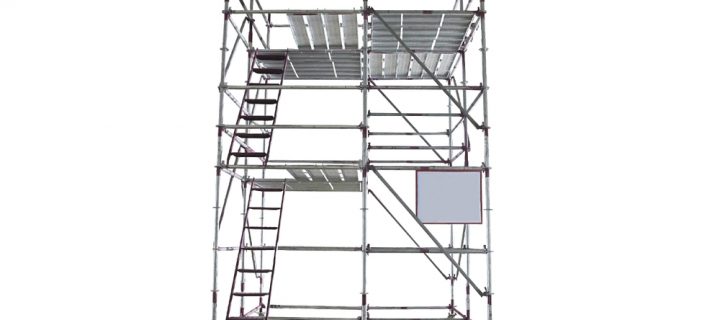When used correctly, scaffolding can be a helpful way for workers to reach high up areas and perform important tasks. However, when not used correctly it can be very dangerous. It is crucial that all managers and supervisors know how to construct a safe working platform and provide sufficient fall protection. The lack of fall protection and the potential collapse of the scaffold are some of the hazards that can happen because of an unstable structure or overloading of weight. Another risk is the danger of being struck by falling tools, debris and work materials plus when scaffolding is dangerously close to overhead power lines it can result in electrocution. If the scaffold is deemed unsafe on a building site. workers will have the right to refuse to use it. Appropriate health and safety equipment is always needed to perform work on these platforms. Employers have the responsibility to ensure that any work tasks performed are done in the safest way possible. Why scaffolding needs to be inspected Before using a scaffold system, a survey of the work area needs to be performed to check for any potential hazards. This means looking for debris, high tension wires, ditches plus unguarded openings. They will also need to check any damage or alterations and if the system needs to be taken apart or moved it will require another inspection before being used to check nothing has become damaged or defective. You will need to know the system’s load capacity before using it as the platform will need to be strong enough to hold the desired weight or it will be at risk of collapsing. Never try to fit more workers onto a scaffold platform than it can safely handle and do not overload it with equipment or materials. Talk to the experts If you have any questions about scaffold systems from Network Scaffold Services, please get in touch today. Our team of experts will be more than happy to...
Read Moreabout Preventing falls on scaffoldingThere are plenty of misconceptions regarding working at height and the use of scaffolding. Here at Network Scaffold Services, we have years of experience supplying scaffold, alloy towers and access scaffolding to clients all across Derby. This is the reason we have put together this guide, so if it is your first time working with us, you know what to expect. When Do I Need Scaffolding? It is the decision of your trader to assess the level of risk and use the most appropriate equipment. For example, fixing a single broken tile on a low roof isn’t the same as installing solar panels 20 stories up. Traders need to ensure their staff are completely safe when working on a property, which means working from the ground, if possible. If working at height is required, the risk of falling must be minimised by using scaffolding. Do I Need a Scaffold Licence? If your builder or scaffolder needs to erect the scaffold within the boundary of your property there is no need for a licence. However, if any part of the scaffold needs to be placed on pavement or the road outside the property, the builder or scaffolder needs to obtain a licence from your local council. While it is their responsibility to get the licence, you will need to check that they have the appropriate paperwork. If there is a risk to the public you must schedule scaffolding work for quiet times or get a highway closure from your local council. Who is responsible for health and safety? For work completed on your home that is not connected with any business; the builder, scaffolder or contractor supplying the scaffolding is responsible for maintaining safety on the site. The rules are different for individuals, partnerships or companies that have construction work carried out as part of their business practices. Property developers and companies managing domestic properties like landlords, rental agents or estate agents fall under this bracket. The Construction (Design and Management) Regulations 2015 state that their main responsibility is to ensure their project is suitably managed and the health and safety of anyone who may be affected by the construction work, including the general public. Contact Network Scaffold with any...
Read Moreabout What are the rules regarding scaffolding?Mobile alloy towers from Network Scaffold combine the best features of several other pieces of equipment that are designed for working at height. Mobile scaffold towers provide a minimal amount of added height and add stability that a conventional extension ladder does not. Also, stepladders can provide a stable platform to work on but lack the significant height that mobile towers provide. If you have never used a mobile access tower before, we have put together five reasons to make the change from conventional height access equipment in this blog. 5 Reasons to Choose Our Mobile Alloy Towers 1. Stability – One of the main reasons to consider a mobile scaffold tower is the stability they provide. Unlike two-legged ladders, mobile towers support themselves standing alone and do not need to be positioned against another structure to remain upright. A mobile tower can maintain stability even when a worker climbs up the access ladder or is working with tools on the working platform. Many mobile towers have additional support legs which can be fitted around the base to increase stability. The support legs act in the same way as extendable legs that are found on mobile cranes or cherry picker vans. Increasing the area of the mobile access tower’s base means the structure is less likely to become unbalanced or tip over when being used. 2. Adaptability – While mobile towers could look ungainly at first glance they are highly adaptable. Providing a safe platform for working at height, they can also be used in jobs both indoors and out. The working platform is surrounded by support bars on each side, allowing workers to carry out tasks on surfaces in front of them plus directly above them. Some mobile scaffold towers also fit together with a modular design, meaning extra height can be added if required. 3. Mobility – Mobility is one of the main reasons our clients choose mobile scaffold towers. Instead of assembling and disassembling a scaffold tower, mobile towers have wheels attached to each of their legs that make them more convenient for different scenarios. The wheels at the base of each leg can be locked and unlocked which allows workers to wheel the tower around...
Read Moreabout Why Should I Use a Mobile Alloy Tower?Alloy towers are one of the most important parts of our scaffolding services, but do you know how to erect them? For this blog, Network Scaffold will share our 12 step guide to erecting stairwell alloy towers. 12 Steps to Using Stairwell Alloy Towers Have two people available to erect all towers for safety reasons. Before the tower is erected you will need to ensure site conditions are safe. Operatives need to be competent and familiarise themselves with the manual for assembly. Sufficient equipment also needs to be available to erect the tower at the height required whilst checking components are not damaged or incompatible plus checking the tower breakdown. Insert the adjustable legs and baseplates into the opening base ladder frames. Place the two ladder frames on the staircase in the position required, roughly 1.5 metres apart with the baseplates fully located on the steps of the staircase with the offset plate facing inwards towards the centre of the frame. Connect the two bottom rungs of the frames using a diagonal brace. The brace hooks should be located at the centre of the bottom rungs of the ladder frames which prevents clashing using an erection platform. Level the frames by turning the adjustable leg nuts so that the bottom rung of the frame on the upper step is at the same level as the top rung of the frame on the lower steps with the adjustable legs extended if necessary to achieve this. Fit a trapdoor platform with the trapdoor end located at the lower part of the stairs, to the bottom rung of the frame on the upper step and to the top rung of the ladder frame on the lower step. Make sure the platform is level. There is a small bubble level on the underside of all stair deck alloy towers to ease levelling. This platform will be used for the temporarily safe erection of the tower and will be removed later when being used further up the tower. From the bottom of the staircase, fit a six rung upper frame to the top of the ladder frame on the lower step. Lock the frames together with the interlock clips. Climb into the middle of...
Read Moreabout How to Erect Stairwell Alloy TowersOne of the questions we receive from clients looking for plastic hoarding is; do I need planning permission for it? According to the Town and Country Planning (Control of Advertisements) Regulations 2007, advertising on a hoarding wall qualifies as what is known as ‘deemed consent.’ Advertisements that are classified as deemed consent does not require planning permission from the local planning authority as long as they comply with particular criteria. For this blog, Network Scaffold will explain construction hoarding and permissions that could be required in greater detail. What is the Criteria of Consent for Construction Hoarding? For advertising on site hoarding to qualify for deemed consent, it will need to meet the following conditions – No advertising is displayed earlier than three months before building operations start. The local planning authority has been notified of the day when the advertisement will be first displayed, at least 14 days before the first display date. The person proposing to display the advertisement needs to notify the local planning authority in writing and send a copy of the relevant planning permission. No advertisement is more than 38 square metres in area No part of the advertisement is more than 4.6 metres above ground level The advertisement won’t be displayed for more than 3 years However, if you need plastic hoarding for construction work in a conservation area, an Area of Outstanding Natural Beauty, a National Park, the Broads or an area of special control, advertising hoardings are not permitted. Final Considerations for Plastic Hoarding Any graphics placed on hoarding walls will only benefit from deemed consent if they are placed on construction sites. Advertisements on hoardings for residential sites will always require consent. Talk to the Specialists Today If you are looking for the finest plastic hoarding on the market, get in touch with Network Scaffold Services today. We are the leading supplier for customers across Derby, Nottingham and the surrounding...
Read Moreabout Do I Need Planning Permission for Plastic Hoarding?Construction hoarding is defined as a fence or barrier between a construction site and the public; with the purpose to simply keep workers safe. Construction sites that are based along pedestrian walkways need plastic hoarding to ensure that there is no interference on-site from the general public. Although additional labour is required, this is definitely a necessary hassle to help keep your site safe. For this blog, Network Scaffold Services will share some of the benefits of hoarding plus some intriguing insights. The Advantages of Construction Hoarding Here are the three main benefits of construction hoarding – Public Safety – As previously mentioned public safety is one of the most benefits of using our construction hoarding. This is the reason a lot of construction sites that are near to public access areas use our products. Hoarding also shows people they cannot enter the area plus you can further enforce the message with signage on your hoarding. To make sure the hoarding is reliable, we would recommend using a system that is wind resistant and safely secured into a base or the ground to prevent tipping. Site Security – One of the best things about using site hoarding is that it keeps your project away from prying eyes. If you are looking to keep your project under wraps, hoarding acts as a visible barrier between your site and the public. The public will also not be able to see your materials and tools being stored on-site, protecting them from potential theft. Branding Your Site – From a marketing perspective, construction hoarding is one of the simplest branding opportunities you can have. Your investment in keeping the public safe can also double as a way to advertise your upcoming project. Branding your site will add brand recognition plus could potentially increase interest and sales once the site opens. Get in Touch for More Information If you have any questions about plastic hoarding available from Network Scaffold Services, please do not hesitate to contact us today. We are also the leading provider of scaffolding and safety decking for clients across...
Read Moreabout What is Construction Hoarding?




